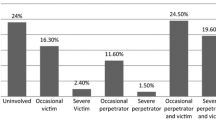Abstract
This research was conducted as a descriptive and relational study to determine the frequency of bullying among high school students and the relationships between some of their characteristics and their roles in the bullying cycle. The research data were obtained from 1670 students in the 9th and 10th grades of six high schools in Istanbul province. The data were analyzed with percentage distribution, Chi square, t test, correlation and Tukey test.The Determination of Peer Bullying Scale and a Personal Information Form were used for data collection in the research. According to the Determination of Peer Bullying Scale 17% of the students were in a bullying cycle (5.3% as bully, 5.9% as victim, and 5.8% as both bully and victim). The boys used more direct methods of bullying and girls more indirect methods of bullying. The rate of bullying behavior was also higher in boys and being a victim was higher in girls; the majority of the girls were bullied by girls and the majority of the boys were bullied by boys. More of those involved in bullying incidents had unexcused absenteeism from school and stated that they did not like school. The results obtained from this research show that the prevalence of bullying in high schools in Turkey is similar to the results in other countries. Determination of the causative factors that support and maintain bullying behavior for implementation of prevention programs is required.
Similar content being viewed by others
References
Olweus D. (Eds.) Bullying At School: What We Know and What We Can Do? Oxford: Blackwell; 1993. p. 13–30.
Espelage DL, Holt MK. Bullying and victimization during early adolescence: peer influences and psychosocial correlates. Binghamton: Haworth; 2003. p. 123–42.
Perkins HJ, Montford CR. The impact of violence on adolescents in schools: a case study on the role of school-based health centers. Nurs Clin North Am. 2005;40:671–9.
Ando M, Asakura T. Psychosocial influences on physical, verbal and indirect bullying among Japanese early adolescents. J Early Adolesc. 2005;25:268–90.
Kapci EG. Bullying type and severity among elementary school students and its relationship with depression, anxiety and self esteem. Ankara University. J Fac Educ Sci. 2004;37(1):1–13.
Piskin M. School Bullying: definition, types, relational factors and preventions. J Educ Sci in Theory Pract. 2002;2:531–62.
Chernick MR, Friis RH. Introductory Biostatistics for the Health Sciences: Modern Applications Including Bootstrap. Wiley Interscience: New Jersey: John Wiley & Sons Publication; 2003. p. 22–46.
Baldry AC, Farrington PD. Bullies and delinquents: personal characteristics and parental styles. J Community Appl Soc Psychol. 2000;10:17–31.
Rigby K, Slee P. Bullying among Australian school children: reported behavior and attitudes towards victims. J Soc Psychol. 1991;131:615–27.
Rigby K. Bullying in school and what to do about it?. Australian Council of Educational Research, Melbourne, ACER; 1996. p. 71–6.
Schwartz D, Dodge KA, Petit GS, Bates JE. The Early socialization of aggressive victims of bullying. Child Dev. 1997;68:665–75.
Uludaglı N, Ucanok Z. Loneliness, academic achievement and types of Bullying behavior according to sociometric status in bully/victim groups. Turk J Psy. 2005;20:77–92.
Balogun SK, Olapegba PO, Opayemi AS. Influence of gender, age, religion and ethnicity on peer-victimization among primary four pupils in Ibada. Stud Tribes Tribals. 2006;4:109–12.
Author information
Authors and Affiliations
Corresponding author
Rights and permissions
About this article
Cite this article
Arslan, S., Savaser, S. & Yazgan, Y. Prevalence of Peer Bullying in High School Students in Turkey and the Roles of Socio-Cultural and Demographic Factors in the Bullying Cycle. Indian J Pediatr 78, 987–992 (2011). https://doi.org/10.1007/s12098-010-0350-4
Received:
Accepted:
Published:
Issue Date:
DOI: https://doi.org/10.1007/s12098-010-0350-4



